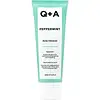What's inside
What's inside
 Key Ingredients
Key Ingredients

No key ingredients
 Benefits
Benefits

 Concerns
Concerns

 Ingredients Side-by-side
Ingredients Side-by-side

Water
Skin ConditioningSodium Coco-Sulfate
CleansingCocamidopropyl Betaine
CleansingCaprylyl/Capryl Glucoside
CleansingDecyl Glucoside
CleansingGlycerin
HumectantMentha Arvensis Leaf Oil
MaskingAllantoin
Skin ConditioningGlyceryl Oleate
EmollientCoco-Glucoside
CleansingLauryl Glucoside
CleansingSodium Phytate
Levulinic Acid
PerfumingSodium Levulinate
Skin ConditioningSodium Benzoate
MaskingCitric Acid
BufferingLimonene
PerfumingLinalool
PerfumingWater
Skin ConditioningSodium Lauroyl Methyl Isethionate
CleansingGlycerin
HumectantCocamidopropyl Betaine
CleansingSodium Methyl Oleoyl Taurate
CleansingSorbitan Oleate Decylglucoside Crosspolymer
CleansingSodium Cocoyl Glycinate
CleansingSclerotium Gum
Emulsion StabilisingPolysorbate 20
EmulsifyingLauryl Glucoside
CleansingCoco-Glucoside
CleansingCamellia Sinensis Leaf Extract
AntimicrobialGlycyrrhiza Glabra Root Extract
BleachingAllantoin
Skin ConditioningChamomilla Recutita Flower Extract
MaskingCucumis Sativus Fruit Extract
EmollientEmblica Officinalis Fruit Extract
Skin ConditioningHydrastis Canadensis Extract
MaskingHippophae Rhamnoides Seed Oil
Skin ProtectingCitrus Paradisi Fruit Extract
Skin ConditioningCitrus Paradisi Seed Extract
MaskingCapsaicin
MaskingHesperidin
EmollientCitrus Reticulata Peel Oil
MaskingAscorbic Acid
AntioxidantLactic Acid
BufferingCitric Acid
BufferingJasminum Officinale Extract
MaskingMangifera Indica Fruit Extract
Skin ConditioningWater, Sodium Lauroyl Methyl Isethionate, Glycerin, Cocamidopropyl Betaine, Sodium Methyl Oleoyl Taurate, Sorbitan Oleate Decylglucoside Crosspolymer, Sodium Cocoyl Glycinate, Sclerotium Gum, Polysorbate 20, Lauryl Glucoside, Coco-Glucoside, Camellia Sinensis Leaf Extract, Glycyrrhiza Glabra Root Extract, Allantoin, Chamomilla Recutita Flower Extract, Cucumis Sativus Fruit Extract, Emblica Officinalis Fruit Extract, Hydrastis Canadensis Extract, Hippophae Rhamnoides Seed Oil, Citrus Paradisi Fruit Extract, Citrus Paradisi Seed Extract, Capsaicin, Hesperidin, Citrus Reticulata Peel Oil, Ascorbic Acid, Lactic Acid, Citric Acid, Jasminum Officinale Extract, Mangifera Indica Fruit Extract
Ingredients Explained
These ingredients are found in both products.
Ingredients higher up in an ingredient list are typically present in a larger amount.
Allantoin is a soothing ingredient known for its protective and moisturizingg properties. Because of this, it is often added to products with strong active ingredients.
Studies show higher concentrations of this ingredient can promote wound healing.
Though it can be derived from the comfrey plant, allantoin is produced synthetically for cosmetic products to ensure purity.
Learn more about AllantoinCitric Acid is an alpha hydroxy acid (AHA) naturally found in citrus fruits like oranges, lemons, and limes.
Like other AHAs, citric acid can exfoliate skin by breaking down the bonds that hold dead skin cells together. This helps reveal smoother and brighter skin underneath.
However, this exfoliating effect only happens at high concentrations (20%) which can be hard to find in cosmetic products.
Due to this, citric acid is usually included in small amounts as a pH adjuster. This helps keep products slightly more acidic and compatible with skin's natural pH.
In skincare formulas, citric acid can:
While it can provide some skin benefits, research shows lactic acid and glycolic acid are generally more effective and less irritating exfoliants.
Most citric acid used in skincare today is made by fermenting sugars (usually from molasses). This synthetic version is identical to the natural citrus form but easier to stabilize and use in formulations.
Read more about some other popular AHA's here:
Learn more about Citric AcidCocamidopropyl Betaine is a fatty acid created by mixing similar compounds in coconut oil and dimethylaminopropylamine, a compound with two amino groups.
This ingredient is a surfactant and cleanser. It helps gather the dirt, pollutants, and other impurities in your skin to be washed away. It also helps thicken a product and make the texture more creamy.
Being created from coconut oil means Cocamidopropyl Betaine is hydrating for the skin.
While Cocamidopropyl Betaine was believed to be an allergen, a study from 2012 disproved this. It found two compounds in unpure Cocamidopropyl Betaine to be the irritants: aminoamide and 3-dimethylaminopropylamine. High-grade and pure Cocamidopropyl Betaine did not induce allergic reactions during this study.
Learn more about Cocamidopropyl BetaineCoco-Glucoside is a surfactant, or a cleansing ingredient. It is made from glucose and coconut oil.
Surfactants help gather dirt, oil, and other pollutants from your skin to be rinsed away.
This ingredient is considered gentle and non-comedogenic. However, it may still be irritating for some.
Learn more about Coco-GlucosideGlycerin is already naturally found in your skin. It helps moisturize and protect your skin.
A study from 2016 found glycerin to be more effective as a humectant than AHAs and hyaluronic acid.
As a humectant, it helps the skin stay hydrated by pulling moisture to your skin. The low molecular weight of glycerin allows it to pull moisture into the deeper layers of your skin.
Hydrated skin improves your skin barrier; Your skin barrier helps protect against irritants and bacteria.
Glycerin has also been found to have antimicrobial and antiviral properties. Due to these properties, glycerin is often used in wound and burn treatments.
In cosmetics, glycerin is usually derived from plants such as soybean or palm. However, it can also be sourced from animals, such as tallow or animal fat.
This ingredient is organic, colorless, odorless, and non-toxic.
Glycerin is the name for this ingredient in American English. British English uses Glycerol/Glycerine.
Learn more about GlycerinLauryl Glucoside sugar- and lipid-based cleansing agent. It is created from glucose and lauryl alcohol.
This ingredient is a surfactant, making it easier to rinse oil, dirt, and other pollutants away.
A British study found lauryl glucoside to cause skin sensitivity for some people. We recommend speaking with a professional if you have concerns.
Other names for this ingredient include "Lauryl Polyglucose", "Lauryl glycoside", and "D-Glucopyranoside".
Learn more about Lauryl GlucosideWater. It's the most common cosmetic ingredient of all. You'll usually see it at the top of ingredient lists, meaning that it makes up the largest part of the product.
So why is it so popular? Water most often acts as a solvent - this means that it helps dissolve other ingredients into the formulation.
You'll also recognize water as that liquid we all need to stay alive. If you see this, drink a glass of water. Stay hydrated!
Learn more about Water